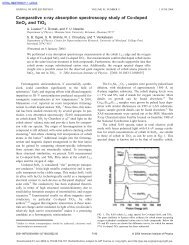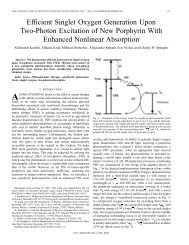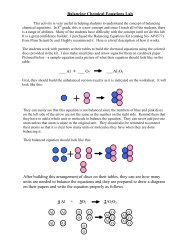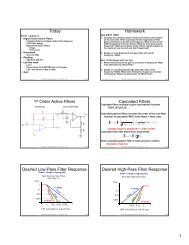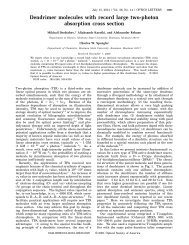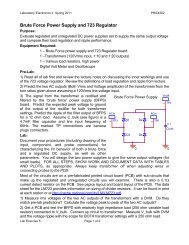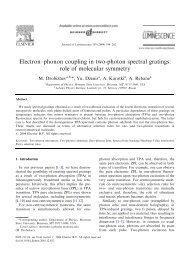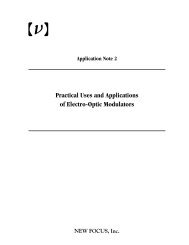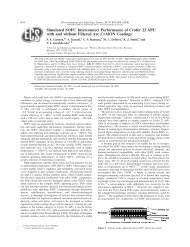Defects in inorganic photorefractive materials and their investigations
Defects in inorganic photorefractive materials and their investigations
Defects in inorganic photorefractive materials and their investigations
You also want an ePaper? Increase the reach of your titles
YUMPU automatically turns print PDFs into web optimized ePapers that Google loves.
32 B. Briat et al.<br />
or – rather Pb 2+ +O − , i.e. the trapped hole has highest density at one of the<br />
O 2− neighbors. Furthermore, a Cu 2+ background defect is identified <strong>in</strong> all <strong>in</strong>vestigated<br />
crystals, which however cannot be recharged by illum<strong>in</strong>ation. The<br />
hole trapp<strong>in</strong>g at Pb 2+ is metastable below ∼ 120 K <strong>and</strong> leads to a wide <strong>and</strong><br />
strong optical absorption, at 2 K start<strong>in</strong>g at 2 eV <strong>and</strong> monotonically <strong>in</strong>creas<strong>in</strong>g<br />
towards the fundamental absorption. As shown by comb<strong>in</strong>ed optical absorption<br />
<strong>and</strong> ODMR-MCD measurements, this coloration is caused by a transition<br />
connected with Pb 2+ -O − . The thermal decay time of this metastable defect<br />
is of the same order as that of the fast <strong>photorefractive</strong> grat<strong>in</strong>g.<br />
The concentration of the Pb trapped holes has been measured to be of the<br />
order of several 10 16 cm −3 , much less than the available Pb 2+ lattice sites.<br />
Therefore the obta<strong>in</strong>able hole concentration is limited by the concentration of<br />
the compensat<strong>in</strong>g donors. All electrons not trapped at these donors recomb<strong>in</strong>e<br />
immediately with the holes, putt<strong>in</strong>g an upper limit to those surviv<strong>in</strong>g. All<br />
attempts have failed so far to identify these donors. If the material could be<br />
doped with a higher concentration of them, once the donors are known, a<br />
sensitive material with a high density of <strong>photorefractive</strong>ly active hole centers<br />
would be available.<br />
7.3 Sr 1−x Ba x Nb 2 O 6 (SBN)<br />
The material crystallizes <strong>in</strong> the tetragonal tungsten bronze structure, melt<strong>in</strong>g<br />
congruently for x =0.61. Only five of the six lattice sites favorable for<br />
<strong>in</strong>corporation of Sr <strong>and</strong> Ba are occupied <strong>in</strong> ideal crystals; the statistical distribution<br />
of the correspond<strong>in</strong>g empty cation sites causes strongly fluctuat<strong>in</strong>g<br />
crystal fields, e.g. at the <strong>in</strong>corporation sites of EPR-active defect ions. Thus<br />
only Ce 3+ (4f 1 ), where the paramagnetic f-electrons are shielded by the outer<br />
electrons from the <strong>in</strong>fluences of the crystal surround<strong>in</strong>gs, was identified by<br />
EPR [189]. This dop<strong>in</strong>g is rather efficient <strong>in</strong> sensitiz<strong>in</strong>g the <strong>photorefractive</strong> effect<br />
for light <strong>in</strong> the energy range 2 to 3 eV [190, 191]. The EPR data <strong>in</strong>dicate<br />
that Ce 3+ enters the crystal at only one of the two crystallographically different<br />
alkal<strong>in</strong>e earth sites - one is 12-fold the other one 15-fold coord<strong>in</strong>ated by<br />
oxygen ions. Whatever its lattice site, EPR shows that Ce 3+ moves off-center,<br />
destroy<strong>in</strong>g all symmetry. This is more likely at the spacious 15-fold coord<strong>in</strong>ated<br />
site than at the other one. Under optical illum<strong>in</strong>ation, e.g. with 488<br />
nm light, the Ce 3+ EPR signal decreases. This is consistent with the lower<strong>in</strong>g<br />
of the Ce 3+ 4f - 5d optical absorption b<strong>and</strong> under such irradiation, peaked<br />
near 2.5 eV [190]. Simultaneously a wide absorption b<strong>and</strong> rises [192], with<br />
maximum near 0.8 eV, which is typical for optical absorption by Nb 4+ (4d 1 )<br />
conduction b<strong>and</strong> polarons. They are created by electrons photoionized from<br />
Ce 3+ . EPR of the paramagnetic Nb 4+ could not be identified. Probably the<br />
EPR signals are too wide to be detected; this is expected to result from the<br />
spatially fluctuat<strong>in</strong>g crystal fields at the Nb sites, where the Nb 4d electrons<br />
are not shielded from <strong>their</strong> surround<strong>in</strong>g distorted octahedra of oxygen ions.<br />
Also crystals doped with Cr were studied with EPR. Only rather fa<strong>in</strong>t <strong>and</strong>





